Molecule Information
General Information of the Molecule (ID: Mol00582)
| Name |
DNA repair protein RAD51 homolog 4 (RAD51D)
,Homo sapiens
|
||||
|---|---|---|---|---|---|
| Synonyms |
R51H3; RAD51 homolog D; RAD51-like protein 3; TRAD; RAD51L3
Click to Show/Hide
|
||||
| Molecule Type |
Protein
|
||||
| Gene Name |
RAD51D
|
||||
| Gene ID | |||||
| Location |
chr17:35092221-35121522[-]
|
||||
| Sequence |
MGVLRVGLCPGLTEEMIQLLRSHRIKTVVDLVSADLEEVAQKCGLSYKALVALRRVLLAQ
FSAFPVNGADLYEELKTSTAILSTGIGSLDKLLDAGLYTGEVTEIVGGPGSGKTQVCLCM AANVAHGLQQNVLYVDSNGGLTASRLLQLLQAKTQDEEEQAEALRRIQVVHAFDIFQMLD VLQELRGTVAQQVTGSSGTVKVVVVDSVTAVVSPLLGGQQREGLALMMQLARELKTLARD LGMAVVVTNHITRDRDSGRLKPALGRSWSFVPSTRILLDTIEGAGASGGRRMACLAKSSR QPTGFQEMVDIGTWGTSEQSATLQGDQT Click to Show/Hide
|
||||
| Function |
Involved in the homologous recombination repair (HRR) pathway of double-stranded DNA breaks arising during DNA replication or induced by DNA-damaging agents. Bind to single-stranded DNA (ssDNA) and has DNA-dependent ATPase activity. Part of the Rad21 paralog protein complex BCDX2 which acts in the BRCA1-BRCA2-dependent HR pathway. Upon DNA damage, BCDX2 acts downstream of BRCA2 recruitment and upstream of RAD51 recruitment. BCDX2 binds predominantly to the intersection of the four duplex arms of the Holliday junction and to junction of replication forks. The BCDX2 complex was originally reported to bind single-stranded DNA, single-stranded gaps in duplex DNA and specifically to nicks in duplex DNA. Involved in telomere maintenance. The BCDX2 subcomplex XRCC2:RAD51D can stimulate Holliday junction resolution by BLM.
Click to Show/Hide
|
||||
| Uniprot ID | |||||
| Ensembl ID | |||||
| HGNC ID | |||||
| Click to Show/Hide the Complete Species Lineage | |||||
Type(s) of Resistant Mechanism of This Molecule
Drug Resistance Data Categorized by Drug
Approved Drug(s)
2 drug(s) in total
| Drug Sensitivity Data Categorized by Their Corresponding Mechanisms | ||||
|
|
||||
| Disease Class: Osteosarcoma | [1] | |||
| Sensitive Disease | Osteosarcoma [ICD-11: 2B51.0] | |||
| Sensitive Drug | Cisplatin | |||
| Molecule Alteration | Expression | Down-regulation |
||
| Experimental Note | Revealed Based on the Cell Line Data | |||
| Cell Pathway Regulation | Cell apoptosis | Activation | hsa04210 | |
| Cell proliferation | Inhibition | hsa05200 | ||
| In Vitro Model | U2OS cells | Bone | Homo sapiens (Human) | CVCL_0042 |
| Experiment for Molecule Alteration |
Western blotting analysis | |||
| Experiment for Drug Resistance |
Survival assay/crystal violet staining assay | |||
| Mechanism Description | miR-103 and miR-107 reduced homology-directed repair and sensitized cells to various DNA damaging agents, including cisplatin and a PARP inhibitor. Mechanistic analyses revealed that both miR-103 and miR-107 directly target and regulate RAD51 and RAD51D, which is critical for miR-103/107-mediated chemosensitization. | |||
| Disease Class: Breast cancer | [1] | |||
| Sensitive Disease | Breast cancer [ICD-11: 2C60.3] | |||
| Sensitive Drug | Cisplatin | |||
| Molecule Alteration | Expression | Down-regulation |
||
| Experimental Note | Revealed Based on the Cell Line Data | |||
| Cell Pathway Regulation | Cell apoptosis | Activation | hsa04210 | |
| Cell proliferation | Inhibition | hsa05200 | ||
| In Vitro Model | MDA-MB-231 cells | Breast | Homo sapiens (Human) | CVCL_0062 |
| Experiment for Molecule Alteration |
Western blotting analysis | |||
| Experiment for Drug Resistance |
Survival assay/crystal violet staining assay | |||
| Mechanism Description | miR-103 and miR-107 reduced homology-directed repair and sensitized cells to various DNA damaging agents, including cisplatin and a PARP inhibitor. Mechanistic analyses revealed that both miR-103 and miR-107 directly target and regulate RAD51 and RAD51D, which is critical for miR-103/107-mediated chemosensitization. | |||
| Disease Class: Cervical cancer | [1] | |||
| Sensitive Disease | Cervical cancer [ICD-11: 2C77.0] | |||
| Sensitive Drug | Cisplatin | |||
| Molecule Alteration | Expression | Down-regulation |
||
| Experimental Note | Revealed Based on the Cell Line Data | |||
| Cell Pathway Regulation | Cell apoptosis | Activation | hsa04210 | |
| Cell proliferation | Inhibition | hsa05200 | ||
| In Vitro Model | Hela cells | Cervix uteri | Homo sapiens (Human) | CVCL_0030 |
| Experiment for Molecule Alteration |
Western blotting analysis | |||
| Experiment for Drug Resistance |
Survival assay/crystal violet staining assay | |||
| Mechanism Description | miR-103 and miR-107 reduced homology-directed repair and sensitized cells to various DNA damaging agents, including cisplatin and a PARP inhibitor. Mechanistic analyses revealed that both miR-103 and miR-107 directly target and regulate RAD51 and RAD51D, which is critical for miR-103/107-mediated chemosensitization. | |||
| Disease Class: Lung cancer | [1] | |||
| Sensitive Disease | Lung cancer [ICD-11: 2C25.5] | |||
| Sensitive Drug | Cisplatin | |||
| Molecule Alteration | Expression | Down-regulation |
||
| Experimental Note | Revealed Based on the Cell Line Data | |||
| Cell Pathway Regulation | Cell apoptosis | Activation | hsa04210 | |
| Cell proliferation | Inhibition | hsa05200 | ||
| In Vitro Model | H1299 cells | Lung | Homo sapiens (Human) | CVCL_0060 |
| Experiment for Molecule Alteration |
Western blotting analysis | |||
| Experiment for Drug Resistance |
Survival assay/crystal violet staining assay | |||
| Mechanism Description | miR-103 and miR-107 reduced homology-directed repair and sensitized cells to various DNA damaging agents, including cisplatin and a PARP inhibitor. Mechanistic analyses revealed that both miR-103 and miR-107 directly target and regulate RAD51 and RAD51D, which is critical for miR-103/107-mediated chemosensitization. | |||
| Disease Class: Ovarian cancer | [1] | |||
| Sensitive Disease | Ovarian cancer [ICD-11: 2C73.0] | |||
| Sensitive Drug | Cisplatin | |||
| Molecule Alteration | Expression | Down-regulation |
||
| Experimental Note | Revealed Based on the Cell Line Data | |||
| Cell Pathway Regulation | Cell apoptosis | Activation | hsa04210 | |
| Cell proliferation | Inhibition | hsa05200 | ||
| In Vitro Model | PEO1 C4-2 cells | Ovary | Homo sapiens (Human) | N.A. |
| Experiment for Molecule Alteration |
Western blotting analysis | |||
| Experiment for Drug Resistance |
Survival assay/crystal violet staining assay | |||
| Mechanism Description | miR-103 and miR-107 reduced homology-directed repair and sensitized cells to various DNA damaging agents, including cisplatin and a PARP inhibitor. Mechanistic analyses revealed that both miR-103 and miR-107 directly target and regulate RAD51 and RAD51D, which is critical for miR-103/107-mediated chemosensitization. | |||
| Drug Sensitivity Data Categorized by Their Corresponding Mechanisms | ||||
|
|
||||
| Disease Class: Osteosarcoma | [1] | |||
| Sensitive Disease | Osteosarcoma [ICD-11: 2B51.0] | |||
| Sensitive Drug | Etoposide | |||
| Molecule Alteration | Expression | Down-regulation |
||
| Experimental Note | Revealed Based on the Cell Line Data | |||
| Cell Pathway Regulation | Cell apoptosis | Activation | hsa04210 | |
| Cell proliferation | Inhibition | hsa05200 | ||
| In Vitro Model | U2OS cells | Bone | Homo sapiens (Human) | CVCL_0042 |
| Experiment for Molecule Alteration |
Western blotting analysis | |||
| Experiment for Drug Resistance |
Survival assay/crystal violet staining assay | |||
| Mechanism Description | miR-103 and miR-107 reduced homology-directed repair and sensitized cells to various DNA damaging agents, including cisplatin and a PARP inhibitor. Mechanistic analyses revealed that both miR-103 and miR-107 directly target and regulate RAD51 and RAD51D, which is critical for miR-103/107-mediated chemosensitization. | |||
| Disease Class: Breast cancer | [1] | |||
| Sensitive Disease | Breast cancer [ICD-11: 2C60.3] | |||
| Sensitive Drug | Etoposide | |||
| Molecule Alteration | Expression | Down-regulation |
||
| Experimental Note | Revealed Based on the Cell Line Data | |||
| Cell Pathway Regulation | Cell apoptosis | Activation | hsa04210 | |
| Cell proliferation | Inhibition | hsa05200 | ||
| In Vitro Model | MDA-MB-231 cells | Breast | Homo sapiens (Human) | CVCL_0062 |
| Experiment for Molecule Alteration |
Western blotting analysis | |||
| Experiment for Drug Resistance |
Survival assay/crystal violet staining assay | |||
| Mechanism Description | miR-103 and miR-107 reduced homology-directed repair and sensitized cells to various DNA damaging agents, including cisplatin and a PARP inhibitor. Mechanistic analyses revealed that both miR-103 and miR-107 directly target and regulate RAD51 and RAD51D, which is critical for miR-103/107-mediated chemosensitization. | |||
| Disease Class: Cervical cancer | [1] | |||
| Sensitive Disease | Cervical cancer [ICD-11: 2C77.0] | |||
| Sensitive Drug | Etoposide | |||
| Molecule Alteration | Expression | Down-regulation |
||
| Experimental Note | Revealed Based on the Cell Line Data | |||
| Cell Pathway Regulation | Cell apoptosis | Activation | hsa04210 | |
| Cell proliferation | Inhibition | hsa05200 | ||
| In Vitro Model | Hela cells | Cervix uteri | Homo sapiens (Human) | CVCL_0030 |
| Experiment for Molecule Alteration |
Western blotting analysis | |||
| Experiment for Drug Resistance |
Survival assay/crystal violet staining assay | |||
| Mechanism Description | miR-103 and miR-107 reduced homology-directed repair and sensitized cells to various DNA damaging agents, including cisplatin and a PARP inhibitor. Mechanistic analyses revealed that both miR-103 and miR-107 directly target and regulate RAD51 and RAD51D, which is critical for miR-103/107-mediated chemosensitization. | |||
| Disease Class: Lung cancer | [1] | |||
| Sensitive Disease | Lung cancer [ICD-11: 2C25.5] | |||
| Sensitive Drug | Etoposide | |||
| Molecule Alteration | Expression | Down-regulation |
||
| Experimental Note | Revealed Based on the Cell Line Data | |||
| Cell Pathway Regulation | Cell apoptosis | Activation | hsa04210 | |
| Cell proliferation | Inhibition | hsa05200 | ||
| In Vitro Model | H1299 cells | Lung | Homo sapiens (Human) | CVCL_0060 |
| Experiment for Molecule Alteration |
Western blotting analysis | |||
| Experiment for Drug Resistance |
Survival assay/crystal violet staining assay | |||
| Mechanism Description | miR-103 and miR-107 reduced homology-directed repair and sensitized cells to various DNA damaging agents, including cisplatin and a PARP inhibitor. Mechanistic analyses revealed that both miR-103 and miR-107 directly target and regulate RAD51 and RAD51D, which is critical for miR-103/107-mediated chemosensitization. | |||
| Disease Class: Ovarian cancer | [1] | |||
| Sensitive Disease | Ovarian cancer [ICD-11: 2C73.0] | |||
| Sensitive Drug | Etoposide | |||
| Molecule Alteration | Expression | Down-regulation |
||
| Experimental Note | Revealed Based on the Cell Line Data | |||
| Cell Pathway Regulation | Cell apoptosis | Activation | hsa04210 | |
| Cell proliferation | Inhibition | hsa05200 | ||
| In Vitro Model | PEO1 C4-2 cells | Ovary | Homo sapiens (Human) | N.A. |
| Experiment for Molecule Alteration |
Western blotting analysis | |||
| Experiment for Drug Resistance |
Survival assay/crystal violet staining assay | |||
| Mechanism Description | miR-103 and miR-107 reduced homology-directed repair and sensitized cells to various DNA damaging agents, including cisplatin and a PARP inhibitor. Mechanistic analyses revealed that both miR-103 and miR-107 directly target and regulate RAD51 and RAD51D, which is critical for miR-103/107-mediated chemosensitization. | |||
Clinical Trial Drug(s)
1 drug(s) in total
| Drug Sensitivity Data Categorized by Their Corresponding Mechanisms | ||||
|
|
||||
| Disease Class: Osteosarcoma | [1] | |||
| Sensitive Disease | Osteosarcoma [ICD-11: 2B51.0] | |||
| Sensitive Drug | Camptothecin | |||
| Molecule Alteration | Expression | Down-regulation |
||
| Experimental Note | Revealed Based on the Cell Line Data | |||
| Cell Pathway Regulation | Cell apoptosis | Activation | hsa04210 | |
| Cell proliferation | Inhibition | hsa05200 | ||
| In Vitro Model | U2OS cells | Bone | Homo sapiens (Human) | CVCL_0042 |
| Experiment for Molecule Alteration |
Western blotting analysis | |||
| Experiment for Drug Resistance |
Survival assay/crystal violet staining assay | |||
| Mechanism Description | miR-103 and miR-107 reduced homology-directed repair and sensitized cells to various DNA damaging agents, including cisplatin and a PARP inhibitor. Mechanistic analyses revealed that both miR-103 and miR-107 directly target and regulate RAD51 and RAD51D, which is critical for miR-103/107-mediated chemosensitization. | |||
| Disease Class: Breast cancer | [1] | |||
| Sensitive Disease | Breast cancer [ICD-11: 2C60.3] | |||
| Sensitive Drug | Camptothecin | |||
| Molecule Alteration | Expression | Down-regulation |
||
| Experimental Note | Revealed Based on the Cell Line Data | |||
| Cell Pathway Regulation | Cell apoptosis | Activation | hsa04210 | |
| Cell proliferation | Inhibition | hsa05200 | ||
| In Vitro Model | MDA-MB-231 cells | Breast | Homo sapiens (Human) | CVCL_0062 |
| Experiment for Molecule Alteration |
Western blotting analysis | |||
| Experiment for Drug Resistance |
Survival assay/crystal violet staining assay | |||
| Mechanism Description | miR-103 and miR-107 reduced homology-directed repair and sensitized cells to various DNA damaging agents, including cisplatin and a PARP inhibitor. Mechanistic analyses revealed that both miR-103 and miR-107 directly target and regulate RAD51 and RAD51D, which is critical for miR-103/107-mediated chemosensitization. | |||
| Disease Class: Cervical cancer | [1] | |||
| Sensitive Disease | Cervical cancer [ICD-11: 2C77.0] | |||
| Sensitive Drug | Camptothecin | |||
| Molecule Alteration | Expression | Down-regulation |
||
| Experimental Note | Revealed Based on the Cell Line Data | |||
| Cell Pathway Regulation | Cell apoptosis | Activation | hsa04210 | |
| Cell proliferation | Inhibition | hsa05200 | ||
| In Vitro Model | Hela cells | Cervix uteri | Homo sapiens (Human) | CVCL_0030 |
| Experiment for Molecule Alteration |
Western blotting analysis | |||
| Experiment for Drug Resistance |
Survival assay/crystal violet staining assay | |||
| Mechanism Description | miR-103 and miR-107 reduced homology-directed repair and sensitized cells to various DNA damaging agents, including cisplatin and a PARP inhibitor. Mechanistic analyses revealed that both miR-103 and miR-107 directly target and regulate RAD51 and RAD51D, which is critical for miR-103/107-mediated chemosensitization. | |||
| Disease Class: Lung cancer | [1] | |||
| Sensitive Disease | Lung cancer [ICD-11: 2C25.5] | |||
| Sensitive Drug | Camptothecin | |||
| Molecule Alteration | Expression | Down-regulation |
||
| Experimental Note | Revealed Based on the Cell Line Data | |||
| Cell Pathway Regulation | Cell apoptosis | Activation | hsa04210 | |
| Cell proliferation | Inhibition | hsa05200 | ||
| In Vitro Model | H1299 cells | Lung | Homo sapiens (Human) | CVCL_0060 |
| Experiment for Molecule Alteration |
Western blotting analysis | |||
| Experiment for Drug Resistance |
Survival assay/crystal violet staining assay | |||
| Mechanism Description | miR-103 and miR-107 reduced homology-directed repair and sensitized cells to various DNA damaging agents, including cisplatin and a PARP inhibitor. Mechanistic analyses revealed that both miR-103 and miR-107 directly target and regulate RAD51 and RAD51D, which is critical for miR-103/107-mediated chemosensitization. | |||
| Disease Class: Ovarian cancer | [1] | |||
| Sensitive Disease | Ovarian cancer [ICD-11: 2C73.0] | |||
| Sensitive Drug | Camptothecin | |||
| Molecule Alteration | Expression | Down-regulation |
||
| Experimental Note | Revealed Based on the Cell Line Data | |||
| Cell Pathway Regulation | Cell apoptosis | Activation | hsa04210 | |
| Cell proliferation | Inhibition | hsa05200 | ||
| In Vitro Model | PEO1 C4-2 cells | Ovary | Homo sapiens (Human) | N.A. |
| Experiment for Molecule Alteration |
Western blotting analysis | |||
| Experiment for Drug Resistance |
Survival assay/crystal violet staining assay | |||
| Mechanism Description | miR-103 and miR-107 reduced homology-directed repair and sensitized cells to various DNA damaging agents, including cisplatin and a PARP inhibitor. Mechanistic analyses revealed that both miR-103 and miR-107 directly target and regulate RAD51 and RAD51D, which is critical for miR-103/107-mediated chemosensitization. | |||
Disease- and Tissue-specific Abundances of This Molecule
ICD Disease Classification 02

| Differential expression of molecule in resistant diseases | ||
| The Studied Tissue | Lung | |
| The Specified Disease | Lung cancer | |
| The Expression Level of Disease Section Compare with the Healthy Individual Tissue | p-value: 1.02E-19; Fold-change: 2.02E-01; Z-score: 6.05E-01 | |
| The Expression Level of Disease Section Compare with the Adjacent Tissue | p-value: 2.53E-07; Fold-change: 2.25E-01; Z-score: 6.50E-01 | |
|
Molecule expression in the normal tissue adjacent to the diseased tissue of patients
Molecule expression in the diseased tissue of patients
Molecule expression in the normal tissue of healthy individuals
|
||
| Disease-specific Molecule Abundances |
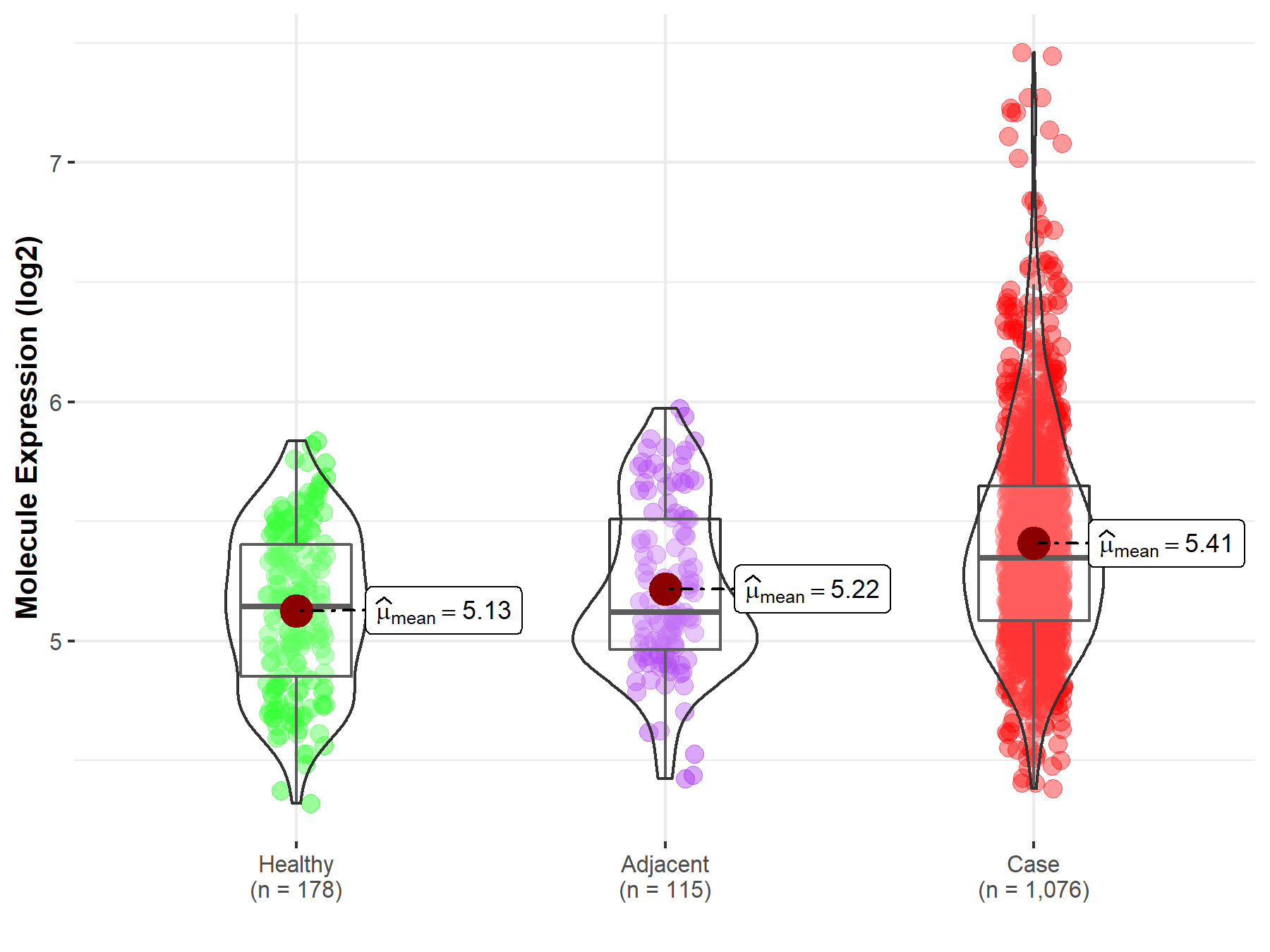
|
Click to View the Clearer Original Diagram |
| Differential expression of molecule in resistant diseases | ||
| The Studied Tissue | Breast tissue | |
| The Specified Disease | Breast cancer | |
| The Expression Level of Disease Section Compare with the Healthy Individual Tissue | p-value: 2.35E-11; Fold-change: 7.91E-02; Z-score: 2.89E-01 | |
| The Expression Level of Disease Section Compare with the Adjacent Tissue | p-value: 8.59E-01; Fold-change: -5.29E-02; Z-score: -1.22E-01 | |
|
Molecule expression in the normal tissue adjacent to the diseased tissue of patients
Molecule expression in the diseased tissue of patients
Molecule expression in the normal tissue of healthy individuals
|
||
| Disease-specific Molecule Abundances |
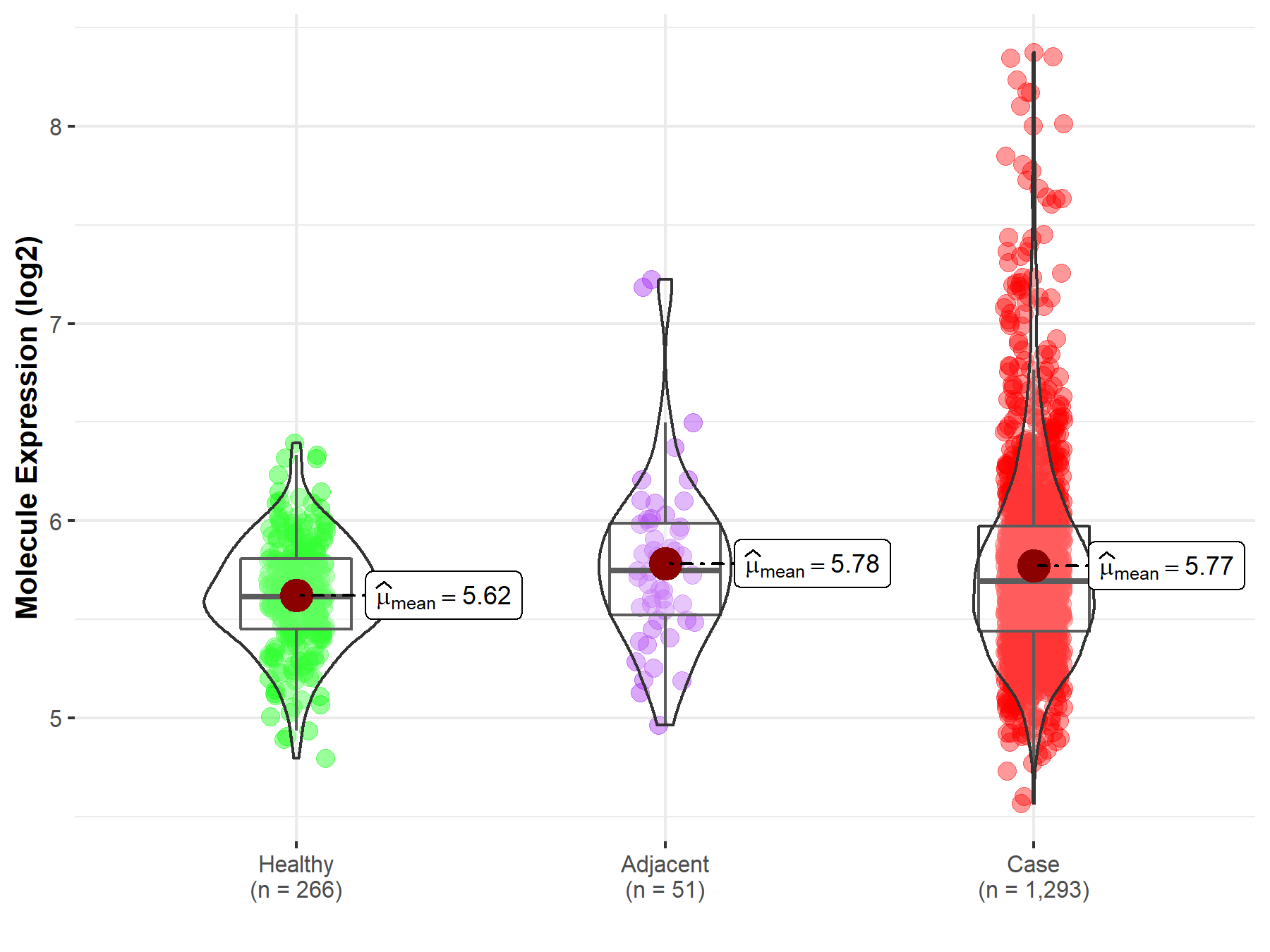
|
Click to View the Clearer Original Diagram |
| Differential expression of molecule in resistant diseases | ||
| The Studied Tissue | Ovary | |
| The Specified Disease | Ovarian cancer | |
| The Expression Level of Disease Section Compare with the Healthy Individual Tissue | p-value: 4.89E-01; Fold-change: -9.07E-02; Z-score: -2.88E-01 | |
| The Expression Level of Disease Section Compare with the Adjacent Tissue | p-value: 6.03E-01; Fold-change: -7.05E-02; Z-score: -1.55E-01 | |
|
Molecule expression in the normal tissue adjacent to the diseased tissue of patients
Molecule expression in the diseased tissue of patients
Molecule expression in the normal tissue of healthy individuals
|
||
| Disease-specific Molecule Abundances |
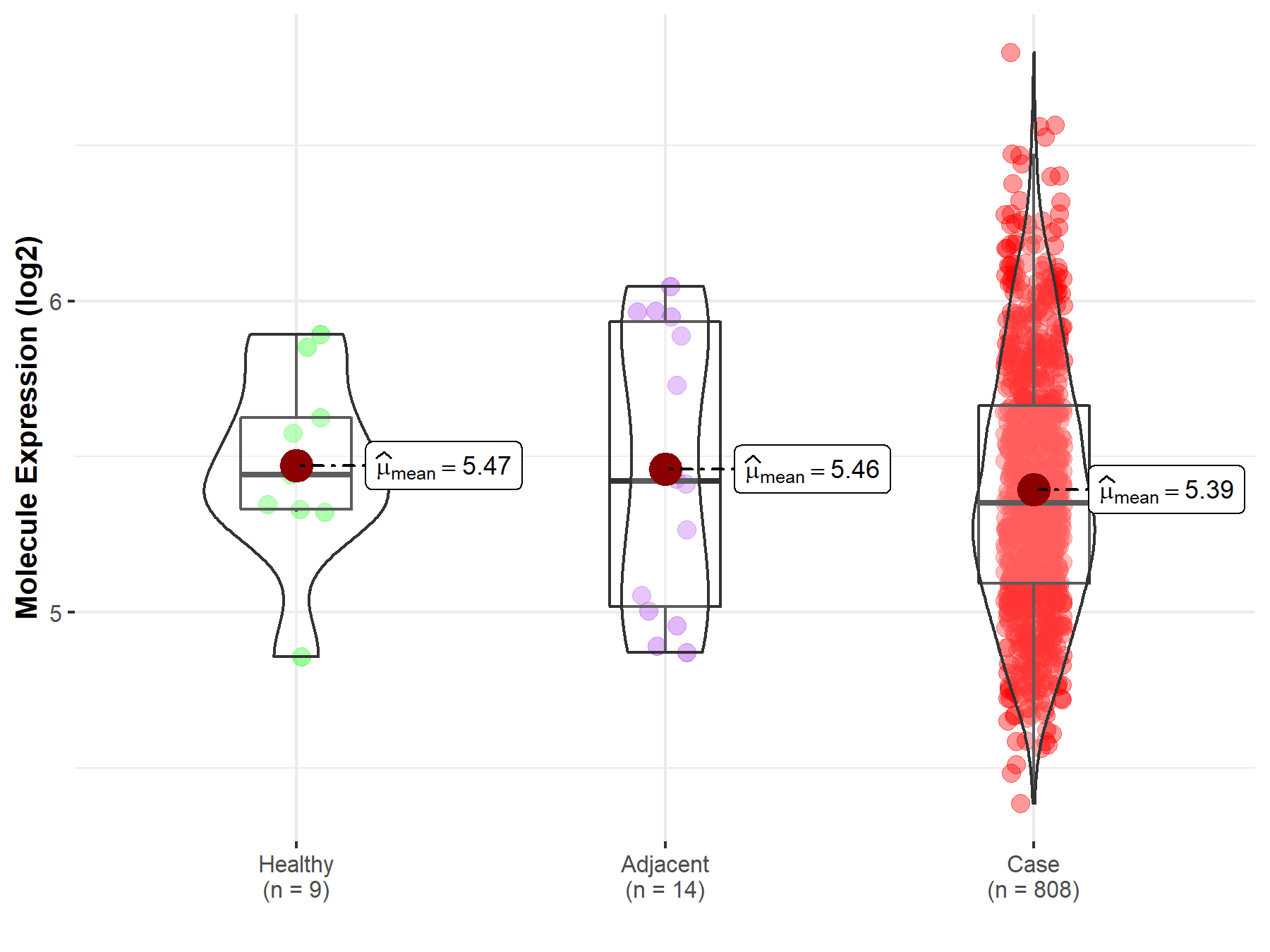
|
Click to View the Clearer Original Diagram |
| Differential expression of molecule in resistant diseases | ||
| The Studied Tissue | Cervix uteri | |
| The Specified Disease | Cervical cancer | |
| The Expression Level of Disease Section Compare with the Healthy Individual Tissue | p-value: 8.60E-01; Fold-change: 3.76E-02; Z-score: 1.40E-01 | |
|
Molecule expression in the diseased tissue of patients
Molecule expression in the normal tissue of healthy individuals
|
||
| Disease-specific Molecule Abundances |
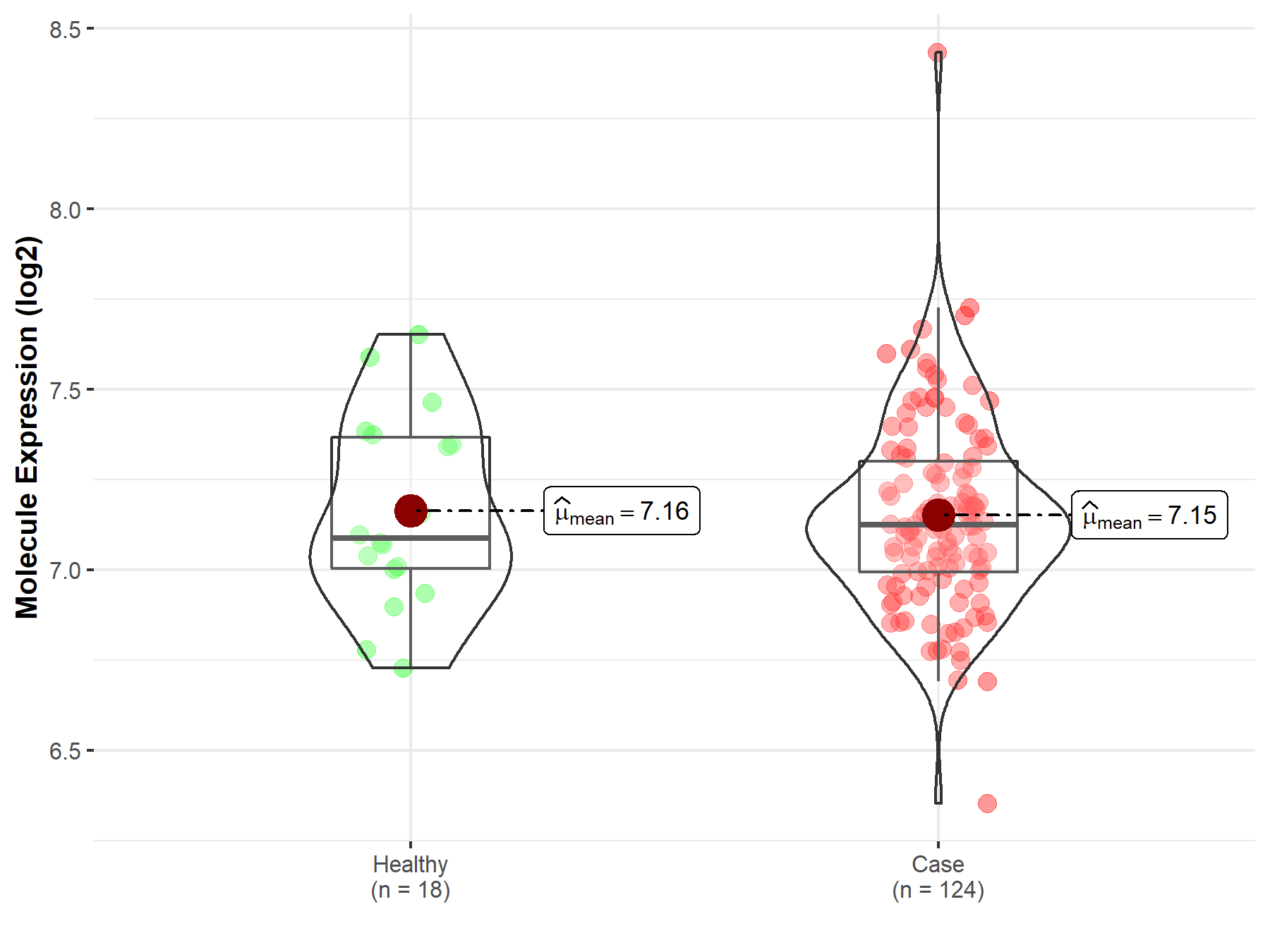
|
Click to View the Clearer Original Diagram |
Tissue-specific Molecule Abundances in Healthy Individuals

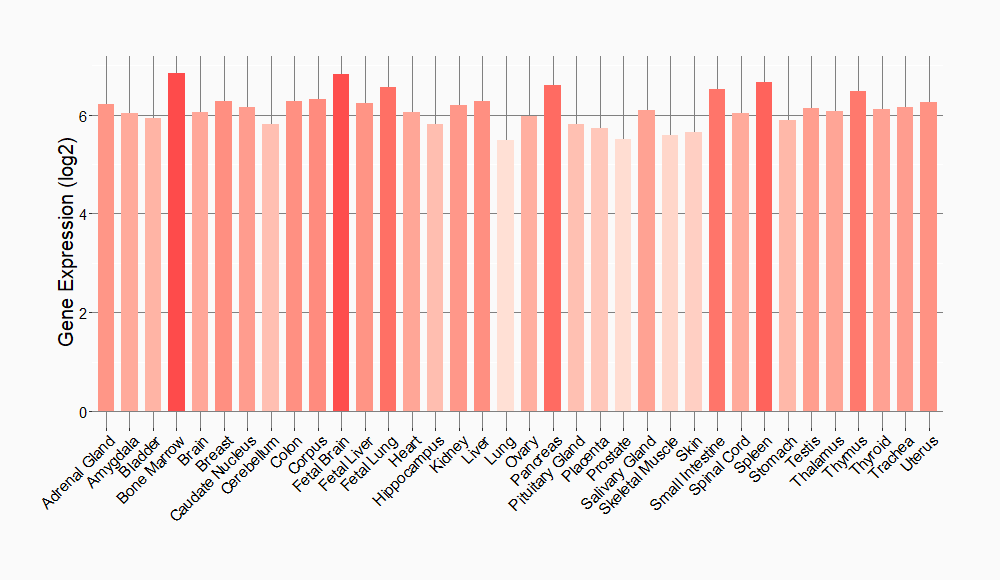
|
||
References
If you find any error in data or bug in web service, please kindly report it to Dr. Sun and Dr. Zhang.
